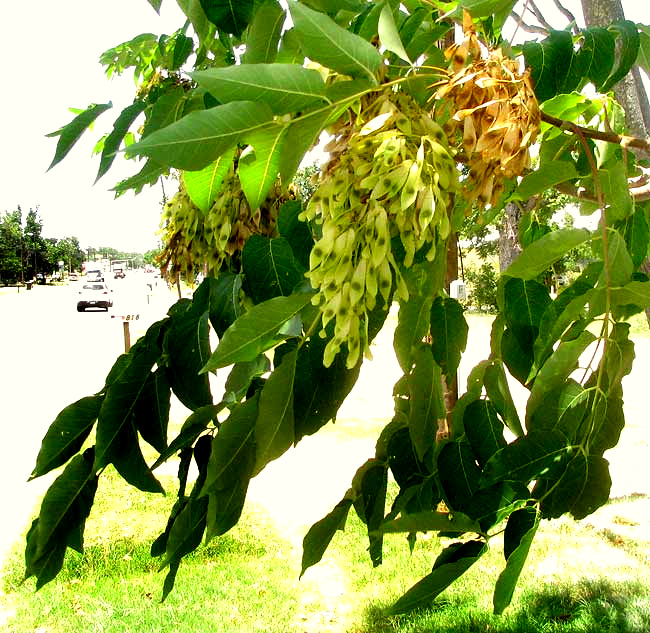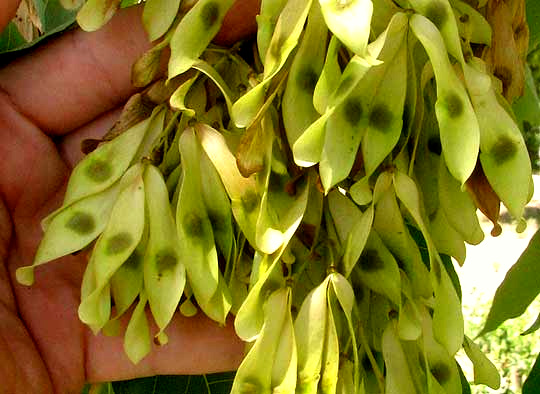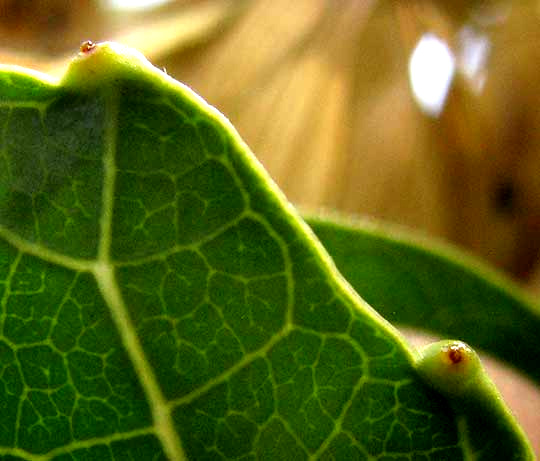Excerpts from Jim Conrad's
Naturalist Newsletter

from the July 20, 2014 Newsletter issued from the Frio Canyon Nature Education Center in the valley of the Dry Frio River in northern Uvalde County, southwestern Texas, on the southern border of the Edwards Plateau; elevation ~1750m (~5750 ft); N29.62°, W99.86°; USA
TREE-OF-HEAVEN
Biking through Uvalde a tree caught my eye enough for me to put on the breaks and go back for a second look. The tree's leaves were similar to those of native and abundantly planted Pecan trees, but this tree was loaded with dense clusters of wafer-like fruits looking nothing like pecans. Those are the leaves and fruits above. A closer look at the samara type-fruits -- samaras being winged fruits that don't split open at maturity -- is shown below:

Back East I got to know this tree during my earliest tree-looking days, for it's often planted in towns and sometimes becomes invasive, pushing aside native trees and forming dense colonies just of itself. In cities it's often planted because it'll grow where other trees won't. The novel A Tree Grows in Brooklyn is referring to this tree. It's the Tree of Heaven, but because of its aggressiveness and stink sometimes it's derisively called "Ghetto Palm", or even "Tree of Hell."
Whatever English name it goes by, it's AILANTHUS ALTISSIMA, native of China and a member of the smallish Quassia Family, the Simarubaceae, whose trees and shrubs occur worldwide but mostly in the tropics. The Tree-of-Heaven has become so well known as an urban tree able to thrive in bad soil and air pollution, and as a weed tree in wilder areas, that it's by far the best known member of its family.
In China it's an important tree. The oldest existing Chinese dictionary, written in the 3rd century BC, mentions the Tree-of-Heaven and in traditional Chinese medicine it's been used for ailments ranging from mental illness to baldness. The roots, leaves and bark are still employed today, and all you have to do to smell the tree's medicinal odor is to brush your hand against the leaves, causing a penetrating, musky, oily odor to fog around you. If you look at leaflet bases you'll see glands, shown below:

Tree-of-Heavens do produce some interesting compounds, including some that are "allelopathic," which means that they retard the growth of, or kill, other plant species in the vicinity. This explains why sometimes you find pure stands of Tree-of-Heavens. The effect is so pronounced that the possibility has been mentioned of using Tree-of-Heaven root extract in water as a natural herbicide.
Tree-of-Heaven also has been grown extensively in China and many other countries as the host plant for the Ailanthus Silkmoth, from whose cocoons silk can be taken.
Betty Smith writes of the Tree-of-Heaven in A Tree Grows in Brooklyn that ... "It grows lushly...survives without sun, water, and seemingly earth. It would be considered beautiful except that there are too many of it.